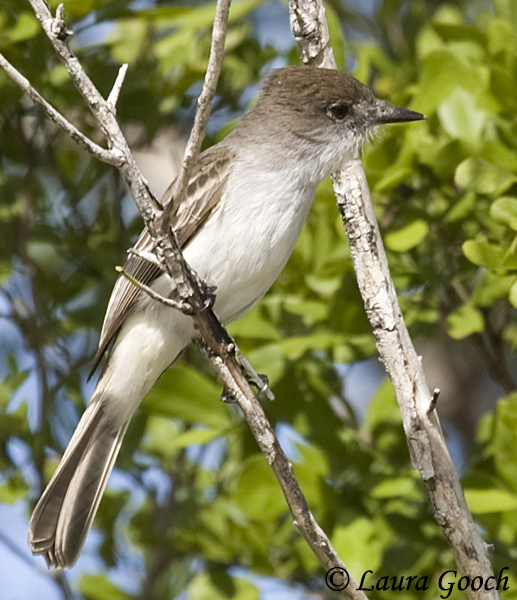| Length: 7.25 inches | Wingspan: 10.5 inches | Seasonality: Non-resident in South Dakota |
| ID Keys: Grayish upperparts, pale underparts with slight or no yellow, dark tail with limited rufous color | ||
 The
La Sagra's Flycatcher is native to Cuba, the Bahamas, and other islands in
the western Caribbean. They were unknown in the United States until a
bird was found in central Alabama in the 1980s. Since then, the
species has been spotted a number of times in southern Florida. They
are similar in structure and general appearance to the confusing group of
other "Myiarchus" flycatchers (Brown-crested
Flycatcher, Ash-throated
Flycatcher, Great Crested
Flycatcher, Dusky-capped
Flycatcher, and Nutting's
Flycatcher). However, most of those species, with the exception of
the Great Crested Flycatcher, are found in western North America. The
La Sagra's Flycatcher can also be distinguished from other Myiarchus
flycatchers by the light underparts that either only have a very slight wash
of yellow, or lack yellow altogether.
The
La Sagra's Flycatcher is native to Cuba, the Bahamas, and other islands in
the western Caribbean. They were unknown in the United States until a
bird was found in central Alabama in the 1980s. Since then, the
species has been spotted a number of times in southern Florida. They
are similar in structure and general appearance to the confusing group of
other "Myiarchus" flycatchers (Brown-crested
Flycatcher, Ash-throated
Flycatcher, Great Crested
Flycatcher, Dusky-capped
Flycatcher, and Nutting's
Flycatcher). However, most of those species, with the exception of
the Great Crested Flycatcher, are found in western North America. The
La Sagra's Flycatcher can also be distinguished from other Myiarchus
flycatchers by the light underparts that either only have a very slight wash
of yellow, or lack yellow altogether.
Habitat: Found in subtropical and tropical forested habitats of the western Caribbean.
Diet: Feeds on insects and spiders, but will also sometimes feed on berries, small fruits, or seeds.
Behavior: Foraging is done by observing from a perch, and flying out to hover and glean insects from foliage, or by capturing insects in mid-air.
Nesting: The nest of a La Sagra's Flycatcher is built in a cavity in a tree, either an old woodpecker hole or a natural cavity. The nesting cavity is lined with weed stems grasses, sticks, and animal hair. The female usually lays 3 or 4 eggs, and she alone incubates them. When the eggs hatch, both parents help to feed and raise the young.
Song: The call of a La Sagra's Flycatcher is a squeaky weeEENK that rises is pitch, and is often given in pairs.
Migration: Considered a permanent resident throughout their normal range in the western Caribbean.
Interactive eBird Map: Click here to access an interactive eBird map of La Sagra's Flycatcher sightings
Similar Species: Similar in appearance to the other Myiarchus flycatchers, but is generally "plainer", with limited or no yellow on the underparts, and a tail that lacks the rich rufous colors of some of the Myiarchus flycatchers. Most similar in appearance to the Ash-throated Flycatcher, a species of the western United States and Mexico, but, like the La Sagra's, a species that has occasionally wandered to parts of the southeastern United States.
Conservation Status: Populations may be in decline, but they are still common in parts of their range and the species currently isn't under major threat. The IUCN lists the La Sagra's Flycatcher as a species of "Least Concern".
Further Information: 1) BirdLife International - La Sagra's Flycatcher
2) Cornell's NeoTropical Birds - La Sagra's Flycatcher
3) Whatbird - La Sagra's Flycatcher
Photo Information: Photo taken by Laura Gooch - Photo licensed under Creative Commons Attribution NonCommercial ShareAlike 2.0 Generic License.
| Click below for a higher-resolution map |
 |
| South Dakota Status: Non-resident in South Dakota |
Additional La Sagra's Flycatcher Photos (coming soon!!)
